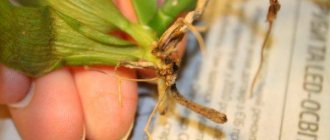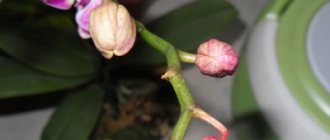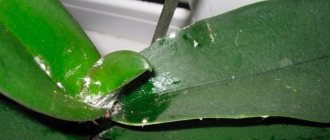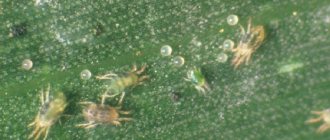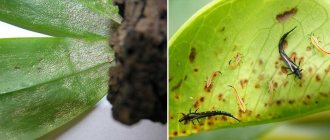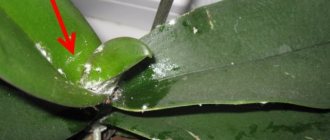With improperly organized care, the orchid is completely a harmful insect may appear mealybug.
It, feeding on the sap of the plant, methodically destroys the foliage and roots of the plant. If urgent measures are not taken, the flower may die.
Below we will tell you in detail how to get rid of mealybugs on an orchid. But first, let’s find out what kind of pest this is.
Description of the pest
The pest belongs to the hemiptera family and is a close relative of the scale insect. Both species are sap-sucking pests.
Types and popular name
This representative of the pest is popularly called white lice. And now science knows more than 1,600 species of these insects that live on various plants. In the photo you can see one of the common types of mealybug.
There are many types of mealybug.
Here are the few species that can be found on an orchid:
- Bristly - has a dense coat and longer hind legs;
- Primorsky - this species is the most prolific, as females lay 400 eggs in one clutch;
- Grape - lives in the southern regions of Russia, and females are colored brown.
IMPORTANT! Whatever mealybug appears on the orchid, it must be eliminated as quickly as possible, otherwise the plant will die.
Description of the adult and larva
In appearance, the insect is similar to the scale insect, but, unlike it, is not covered with a shell and has a white body color. The insect is very mobile and therefore, if it is noticed on one orchid, the plant should be immediately isolated in a quarantine zone, and the remaining orchids should be carefully examined for the presence of the pest.
The mobility of an insect does not depend on its age . Depending on the species, the size of the mealybug can be from 3 to 12 mm.
Male:
- Has wings;
- Well developed limbs;
- It has 2 tail filaments on the abdomen;
- Does not have an oral cavity (do not eat during their life).
Female:
- Has an oral cavity;
- Some species do not have legs;
- They have a cotton-like sac from which live larvae emerge, which are very mobile immediately after birth.
Larva:
- Mobile for some time before molting;
- Then it sticks to the leaf and will remain motionless until molting occurs;
- It has a white body color and looks like a small worm.
IMPORTANT! The female begins her reproduction only in secluded places of the plant, for example in the leaf axils.
What conditions are favorable for reproduction?
When fertilizing the soil in which houseplants grow, be extremely careful. You should not use the fertilizer in large quantities - this can create excellent conditions for the proliferation of pests. Mealybugs settle on indoor plants, which are regularly fed with large amounts of fertilizer containing nitrogen. These are excellent conditions for the pest.
The ideal temperature for reproduction is +24°-27°C. Mealybugs lay many eggs and the larvae hatch very quickly. Plants that are healthy are practically not threatened by pest attacks. Like any living organism, domestic flowers produce special protective substances and can independently repel the mealybug, having excellent immunity. But in the winter season the mechanism of metabolic processes is disrupted. The length of the day is decreasing, plants receive little light, and the air in the apartment is dry due to working central heating radiators. Flowers become weaker and the risk of scale insects increases.
Damage to the plant
Under the conditions necessary for it, the mealybug quickly spreads throughout the orchid. If the disease is detected in the initial stage, treatment will be faster and more effective. By feeding, the harmful insect harms the plant :
- Deprives the nutritional juice necessary for uniform development;
- The plant is stunted;
Mealybugs cause the orchid leaves to turn yellow. - Foliage damaged by bites takes on a yellow tint;
- The plaque left by the scale insect attracts fungal and bacterial diseases.
It is necessary to take treatment measures in a timely manner so as not to lose the plant.
Folk recipes
- Garlic tincture: 5 cloves of a medium-sized garlic head, pour 200 ml of boiling water, leave until completely cool, dilute with boiled water 1:1, spray or wipe all accessible parts of the orchid.
- Alcohol solution with soap: dilute 30 ml of liquid soap in 200 ml of boiled and cooled water and add 2 tablespoons of 70 percent alcohol. Mix thoroughly and apply with a small brush to the leaves and axillary parts of the orchid in places where insect colonies accumulate.
- Infusion of horsetail: Brew one bag of dried horsetail herb in 200 ml of boiling water, cool and wipe or spray the plant several times at intervals of 5-7 days.
- Onion tincture: peel a medium onion, chop, add warm water (250 ml), leave for 5-6 hours, strain, spray on orchid leaves, once a week you can water the soil to disinfect the substrate.
Infection
Symptoms
To determine what kind of pest an orchid is affected by, it is necessary to diagnose it correctly , and for this you need to know the signs of damage to the plant.
The scale insects gather in groups in the axils of leaf blades and their undersides.
The scale insect can be seen with the naked eye, as the length of its body is quite noticeable. First of all, these are cotton bags where the female parasites lay their clutches. The plant seems to be covered with cotton balls.
How does infection occur?
You can introduce a pest:
- By purchasing an already infected plant specimen in a store;
- Or bring larvae from contact with infected flowers.
Therefore, newly purchased flowers are always placed in a quarantine zone to be sure that they are free of pests.
Causes
Possible reasons why an orchid may become infected:
- Constant bays of plants;
Mealybugs often appear due to overwatering or low temperatures. - Low temperatures;
- When dead parts of a plant are removed at the wrong time.
IMPORTANT! To prevent the plant from being attacked by a pest, it must be properly cared for.
External signs
Initially, the insect is located only in the axils of the leaves. But in the process of its reproduction it spreads very quickly throughout the entire plant, covering it with a cottony coating :
- Flowers;
- Peduncles;
- Leaves;
- Then its larvae fall into the ground and begin to destroy the root mass.
The infected flower is evenly covered with cotton balls in which pests grow.
Why do parasites appear?
If the orchid is completely healthy, it independently protects itself from pests. Due to the fact that it can produce special substances that do not allow insects to settle on the plant.
The appearance of scale insects indicates a weakening of the orchid. It occurs as a result of metabolic disorders, due to deterioration of living conditions or errors in care. Most often, infection occurs in winter, when the ambient temperature, lighting, and humidity change.
It is possible that you purchased an unhealthy plant. For some time the parasites were not visible, but as soon as they adapted to the new conditions they began to multiply intensively.
It happens that an orchid grew and bloomed absolutely normally for a long time, but suddenly scale insects appeared. For some reason, the plant was unable to protect itself. This means it has weakened. This occurs as a result of violation of the rules of care:
Aeration has deteriorated.
Due to stagnation of air on the roots of the orchid, velamen is poorly produced. respiratory and nutritional processes fail. This causes the plant to weaken and become easy prey for pests.
Velamen is a spongy substance on the roots of an orchid. Serves to absorb nutrients from the air.
“Unique plants - orchids”,
author - A.K. Mokrousovskaya.
Air humidity has increased or decreased.
There is a violation of sap flow, which leads to a decrease in immunity. As a result, fungal or bacterial diseases actively develop, weakening the plant. When an orchid cannot protect itself, then in addition to diseases, pests quickly become attached to it.
Temperature violation. Sunburn is especially dangerous. They impede normal sap flow
In winter, it is important to ensure that the thermometer readings do not fall below +120.
Irrigation failures - excessive waterlogging or lack of water. Most often, sudden changes from stagnant moisture to drought lead to weakening of the orchid.
Fighting methods
How to deal with mealybugs so as not to greatly harm the orchid?
Physical methods
Physical pest control measures can be used. If the infection is in the initial stage, then the harmful insect can be gotten rid of mechanically without using chemicals.
Methodology
How to cure an orchid physically? To remove the parasite from the leaf mass, you will need :
- Cotton pad;
- Or a soft toothbrush.
They are moistened in soapy water and the orchid is carefully washed from the cotton balls. In hard-to-reach places, you can use cotton swabs, since before treatment you need to carefully get rid of all insects.
Hot shower
There are different ways to remove mealybugs on flower buds. One of them is watering the orchid with a hot shower.
The water temperature, comfortable for orchids, should not exceed 30 degrees . This can be easily determined by placing your hand under running water. If water is pleasant for a person in terms of warmth, then the orchid will like it. But the thermometer is still more accurate


